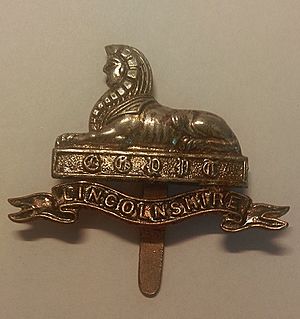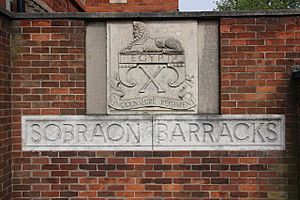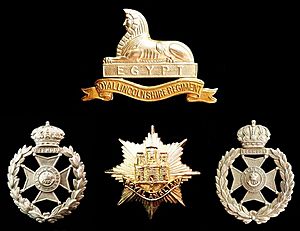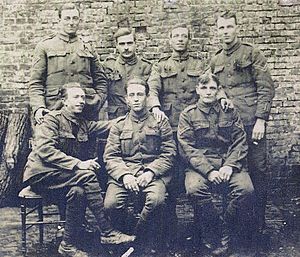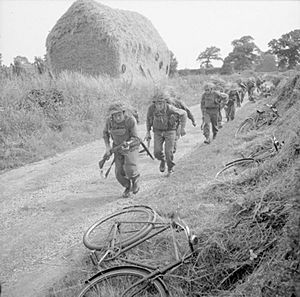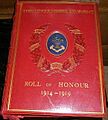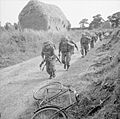Royal Lincolnshire Regiment facts for kids
Quick facts for kids Earl of Bath's Regiment10th (North Lincoln) Regiment of Foot Lincolnshire Regiment Royal Lincolnshire Regiment |
|
|---|---|
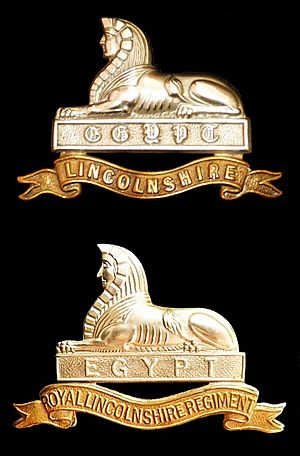
Lincolnshire Regiment and Royal Lincolnshire Regiment cap badges
|
|
| Active | 1685–1960 |
| Country | |
| Branch | |
| Type | Line infantry |
| Role | Infantry |
| Size | Varied |
| Garrison/HQ | The Old Barracks, Lincoln (1873–1880) Sobraon Barracks, Lincoln (1880–1960) |
| Nickname(s) | "The Yellow Bellies" "the Springers" |
| Engagements | Nine Years' War War of the Spanish Succession (Blenhein, Ramillies & Malplaquet) American War of Independence (Lexington, Bunker Hill, New York and New Jersey campaign, Germantown, Monmouth, & Rhode Island) French Revolutionary Wars Napoleonic Wars Peninsular War First World War Second World War |
The Royal Lincolnshire Regiment was a famous infantry (foot soldier) unit of the British Army. It was started on June 20, 1685. Its first name was the Earl of Bath's Regiment, named after its first leader, John Granville, 1st Earl of Bath. In 1751, it became the 10th (North Lincoln) Regiment of Foot. Later, in 1881, it was renamed the Lincolnshire Regiment. This new name came from the county of Lincolnshire, where the regiment had been finding new soldiers since 1781.
After the Second World War, the regiment was called the Royal Lincolnshire Regiment. In 1960, it joined with the Northamptonshire Regiment. They formed a new unit called the 2nd East Anglian Regiment. This new regiment then joined with other units to create the Royal Anglian Regiment. Today, 'A' Company of the 2nd Battalion of the Royal Anglians still carries on the traditions of the Royal Lincolnshire Regiment.
Contents
History of the Regiment
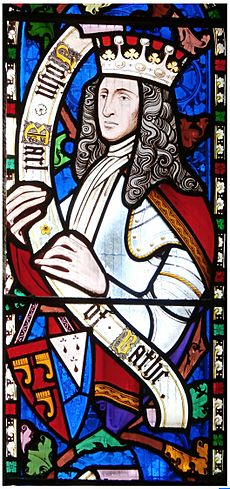
Early Battles and Changes
The regiment began on June 20, 1685, as the Earl of Bath's Regiment. It was first based in Plymouth. In 1688, it joined William III during the Glorious Revolution.
When the Nine Years' War started in 1689, the regiment went to Ostend. They fought in the Battle of Steenkerque in August 1692. About 50 of their soldiers were killed or hurt. They also served at the Siege of Namur in July 1695. After this, they returned to England.
During the War of the Spanish Succession (1701-1714), the regiment fought in several big battles:
- Blenheim in August 1704
- Ramillies in May 1706
- Malplaquet in September 1709
In 1751, all British regiments were given numbers instead of their leader's name. So, it became the 10th Regiment of Foot. It also helped stop a French attack at Carrickfergus during the Seven Years' War.
Fighting in America
The regiment then fought in the American Revolutionary War. They were involved in many important battles:
- Battles of Lexington and Concord in April 1775
- Battle of Bunker Hill in June 1775
- New York Campaign in winter 1776
- Battle of Germantown in October 1777
- Battle of Monmouth in June 1778
- Battle of Rhode Island in August 1778
In 1778, the 10th Regiment returned to England after 19 years overseas. In 1782, it became linked to the county of Lincolnshire for finding new soldiers.
Napoleonic Wars and India
In 1800, the regiment went to Egypt for the French Revolutionary Wars. They took part in the Battle of Alexandria in March 1801.
Later, the 1st battalion went to Spain in 1812 for the Peninsular War. They fought in the Battle of Castalla in April 1813 and the Siege of Tarragona in June 1813.
In 1842, the 10th Foot was sent to India. They fought bravely in the First Anglo-Sikh War at the Battle of Sobraon in February 1846. They also saw action in the Second Anglo-Sikh War. This included the Relief of Multan in January 1849 and the Battle of Gujrat in February 1849.
During the Indian Rebellion in 1857, the regiment helped relieve Lucknow. A soldier named Private Denis Dempsey earned the Victoria Cross for his bravery there.
Victorian Era Changes
From 1868 to 1871, the 1st Battalion served in Japan. They protected foreign communities in Yokohama. Their band leader, John William Fenton, is famous in Japan for starting band music there. He also helped make Kimi ga Yo the national anthem.
In 1873, the regiment got a base in Lincoln at the "old barracks". In 1880, they moved to the "new barracks". On July 1, 1881, the regiment officially became The Lincolnshire Regiment.
The regiment also gained new battalions from local volunteer groups. The 1st Battalion Lincolnshire Regiment went to Malta in 1895. They fought in the Battle of Omdurman in September 1898 during the Mahdist War. The 2nd Battalion went to South Africa in January 1900 and fought in the Second Boer War.
In 1908, the army was reorganized. The regiment now had one reserve battalion and two territorial battalions.
The First World War (1914-1918)
The regiment had five battalions at the start of the First World War.
- The 1st Lincolns were in Portsmouth.
- The 2nd Lincolns were in Bermuda.
- The 3rd was in Lincoln.
- The 4th and 5th Battalions were Territorial units based in Lincolnshire.
Regular Army in WWI
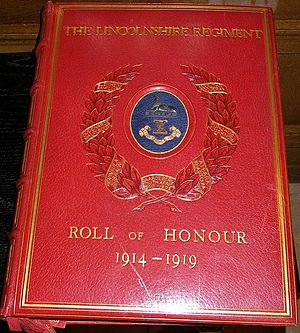
The 1st Battalion went to the Western Front in August 1914. They fought in the First Battle of Ypres and the Battle of Bellewaarde.
The 2nd Lincolns left Bermuda in October 1914 and also went to the Western Front. They fought in the Battle of Aubers Ridge and the Battle of the Somme. They suffered many losses in these battles.
A group of 88 soldiers from the Bermuda Volunteer Rifle Corps joined the 1st Lincolns in June 1915. They were the first colonial volunteer unit to reach the Western Front. Many of them were lost in battle. The survivors joined a second group from Bermuda. By the end of the war, over 75% of these Bermudian soldiers had been lost.
After the war in 1918, the 1st and 3rd Lincolns were sent to Ireland. They helped deal with problems during the Irish War of Independence.
New Armies in WWI
Several new battalions were formed during the war.
- The 6th (Service) Battalion fought at Suvla Bay in Gallipoli in August 1915. They later moved to Egypt and then to France.
- The 7th (Service) Battalion and 8th (Service) Battalion also served on the Western Front from 1915.
- The 10th (Service) Battalion, known as the Grimsby Chums, arrived in France in January 1916. They fought on the Somme and at the Battle of Passchendaele.
The Second World War (1939-1945)

When the Second World War began in September 1939, the 4th and 6th Territorial Army battalions were called up. The 2nd Battalion went to France in October 1939. They were part of the British Expeditionary Force (BEF). Both the 2nd and 6th Battalions managed to escape from Dunkirk after battles in France and Belgium.
After returning to England, the 2nd Battalion trained for four years. They then took part in the D-Day landings in June 1944. They fought in the Normandy Campaign and throughout Northwest Europe until May 1945.
The 1st Battalion was in British India. They fought against the Imperial Japanese Army in the Burma Campaign. In early 1944, during the Battle of the Admin Box, Major Charles Ferguson Hoey was awarded the Victoria Cross for his bravery. He was the only soldier in the Lincolnshire Regiment to receive this award in the Second World War.
The 4th Battalion went to Norway in 1940. They were among the first British soldiers to fight the advancing enemy. They were later sent to Iceland. After two years, they returned to the UK to prepare for the invasion of France.
The 6th Battalion went to Tunisia in January 1943. In September 1943, they landed at Salerno in Italy. They suffered heavy losses but captured Naples and fought in the Battle of Monte Cassino. They later went to Greece to help keep order during the Greek Civil War.
The regiment also formed the 7th and 8th Battalions. However, these units were later changed into other types of army units.
The Bermuda Volunteer Rifle Corps again sent soldiers to join the Lincolns. Many Bermudian officers served with the regiment during the war.
After the Wars
After the Second World War, the 4th and 6th battalions were reformed. But in 1950, the 6th merged with the 4th to become the 4th/6th Battalion. In 1948, the 2nd Battalion joined with the 1st Battalion.
The Royal Lincolnshire Regiment kept its close connection with the Bermuda Volunteer Rifle Corps. In 1960, the regiment joined with the Northamptonshire Regiment. They formed the 2nd East Anglian Regiment. This regiment later joined with others to create the Royal Anglian Regiment in 1964.
The Royal Anglian Regiment continues the special relationship with the Bermuda Regiment (which was formed in 1965). Today, 674 Squadron Army Air Corps uses the sphinx symbol. This is to honor its connection with the Royal Lincolnshire Regiment.
Regimental Museum
You can see collections from the Royal Lincolnshire Regiment and the Lincolnshire Yeomanry at the Museum of Lincolnshire Life in Lincoln. There are also items about the Bermuda Volunteer Rifle Corps soldiers who served with the Lincolns. These are displayed at the Bermuda Maritime Museum in the Royal Naval Dockyard, Bermuda.
Victoria Cross Heroes
The Victoria Cross is the highest award for bravery in the British military. These brave soldiers from the Regiment received it:
- Private Denis Dempsey, Indian Mutiny (1857-1858)
- Lieutenant Henry Marshman Havelock-Allan, Indian Mutiny (1857)
- Private John Kirk, Indian Mutiny (1857)
- Lance-Sergeant Arthur Evans, First World War (1918)
- Captain Percy Hansen, First World War (1915)
- Temp Major Charles Ferguson Hoey, Second World War (1944)
- Acting Corporal Charles Richard Sharpe, First World War (1915)
- Captain John Brunt, Second World War (1944)
Images for kids
-
John Granville, 1st Earl of Bath, founder of the regiment, portrayed in stained glass
-
The Roll of Honour 1914–1919 contains over 8000 names of men. It is displayed in a wooden case in the Services Chapel of Lincoln Cathedral
-
Governor of Bermuda and General Officer Commanding the Bermuda Command, Lieutenant-General Sir Denis Bernard, inspects the First Contingent of the BVRC to the Lincolnshire Regiment at Prospect Camp, Bermuda on 22 June 1940



